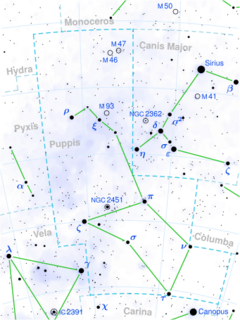Astronomy:Xi Puppis
| Observation data Equinox J2000.0]] (ICRS) | |
|---|---|
| Constellation | Puppis |
| Right ascension | 07h 49m 17.65567s[1] |
| Declination | −24° 51′ 35.2305″[1] |
| Apparent magnitude (V) | 3.35[2] |
| Characteristics | |
| Spectral type | G6 Iab-Ib[3] |
| U−B color index | +1.18[2] |
| B−V color index | +1.25[2] |
| Astrometry | |
| Radial velocity (Rv) | +2.7[4] km/s |
| Proper motion (μ) | RA: −4.81[1] mas/yr Dec.: −0.89[1] mas/yr |
| Parallax (π) | 2.72 ± 0.21[1] mas |
| Distance | 1,200 ± 90 ly (370 ± 30 pc) |
| Absolute magnitude (MV) | –4.73[5] |
| Details | |
| Mass | 9.9 ± 1.0[3] M☉ |
| Luminosity | 60,000[6] L☉ |
| Surface gravity (log g) | 1.21 ± 0.09[3] cgs |
| Temperature | 4,880 ± 150[3] K |
| Metallicity [Fe/H] | +0.24[7] dex |
| Rotational velocity (v sin i) | 9.2[8] km/s |
| Age | 23[3] Myr |
| Other designations | |
| Database references | |
| SIMBAD | data |
Xi Puppis (ξ Puppis, abbreviated Xi Pup, ξ Pup) is a multiple star system in the southern constellation of Puppis. With an apparent visual magnitude of 3.35,[2] it is one of the brighter members of this constellation. Based on parallax measurements made during the Hipparcos mission, it is located approximately 1,200 light-years (370 parsecs) from the Sun, with a 7.5% margin of error.[1]
The system consists of a spectroscopic binary, designated Xi Puppis A,[9] together with a third companion star, Xi Puppis B. A's two components are themselves designated Xi Puppis Aa (formally named Azmidi /ˈæzmɪdi/)[10] and Ab.
Nomenclature
ξ Puppis (Latinised to Xi Puppis) is the system's Bayer designation. The designations of the two constituents as Xi Puppis A and B, and those of A's components - Xi Puppis Aa and Ab - derive from the convention used by the Washington Multiplicity Catalog (WMC) for multiple star systems, and adopted by the International Astronomical Union (IAU).[11]
The system was sometimes known as Asmidiske (Azmidiske), a misspelling and misplacement of Aspidiske (from the Greek for 'little shield), the traditional name of Iota Carinae.[12] In 2016, the IAU organized a Working Group on Star Names (WGSN)[13] to catalog and standardize proper names for stars. The WGSN decided to attribute proper names to individual stars rather than entire multiple systems.[14] It approved the name Azmidi for the component Xi Puppis Aa on 1 June 2018 and it is now so included in the List of IAU-approved Star Names.[10]
Properties
Because of the distance of this system from the Earth, its visual magnitude is reduced by 0.73 as a result of extinction from the intervening gas and dust.[5]
Xi Puppis A presents as a yellow supergiant of spectral class G6 with a luminosity 8,300 times that of the Sun.[12]
The 13th-magnitude companion, Xi Puppis B, is about 5 arcseconds distant and is a Sun-like star that orbits at least 2000 AU away with an orbital period of at least 26,000 years.[12]
References
- ↑ Jump up to: 1.0 1.1 1.2 1.3 1.4 1.5 van Leeuwen, F. (November 2007), "Validation of the new Hipparcos reduction", Astronomy and Astrophysics 474 (2): 653–664, doi:10.1051/0004-6361:20078357, Bibcode: 2007A&A...474..653V
- ↑ Jump up to: 2.0 2.1 2.2 2.3 Johnson, H. L. et al. (1966), "UBVRIJKL photometry of the bright stars", Communications of the Lunar and Planetary Laboratory 4 (99): 99, Bibcode: 1966CoLPL...4...99J
- ↑ Jump up to: 3.0 3.1 3.2 3.3 3.4 Lyubimkov, Leonid S. et al. (February 2010), "Accurate fundamental parameters for A-, F- and G-type Supergiants in the solar neighbourhood", Monthly Notices of the Royal Astronomical Society 402 (2): 1369–1379, doi:10.1111/j.1365-2966.2009.15979.x, Bibcode: 2010MNRAS.402.1369L
- ↑ Wilson, R. E. (1953). "General Catalogue of Stellar Radial Velocities". Carnegie Institute Washington D.C. Publication (Carnegie Institute of Washington D.C.). Bibcode: 1953GCRV..C......0W.
- ↑ Jump up to: 5.0 5.1 Luck, R. E. (May 1, 1982), "The chemical composition of late-type supergiants. IV - Homogeneous abundances and galactic metallicity trends", Astrophysical Journal, Part 1 256: 177–188, doi:10.1086/159895, Bibcode: 1982ApJ...256..177L
- ↑ Reimers, D.; Huensch, M.; Schmitt, J. H. M. M.; Toussaint, F. (1996). "Hybrid stars and the reality of "dividing lines" among G to K bright giants and supergiants". Astronomy and Astrophysics 310: 813. Bibcode: 1996A&A...310..813R.
- ↑ Malagnini, M. L.; Morossi, C.; Buzzoni, A.; Chavez, M. (2000). "Observations and Atmospheric Parameters of Super-Metal-rich Candidates". The Publications of the Astronomical Society of the Pacific 112 (777): 1455. doi:10.1086/317714. Bibcode: 2000PASP..112.1455M.
- ↑ De Medeiros, J. R.; Udry, S.; Burki, G.; Mayor, M. (2002). "A catalog of rotational and radial velocities for evolved stars. II. Ib supergiant stars". Astronomy and Astrophysics 395: 97–98. doi:10.1051/0004-6361:20021214. Bibcode: 2002A&A...395...97D.
- ↑ "Washington Double Star Catalog". United States Naval Observatory. http://ad.usno.navy.mil/wds/.
- ↑ Jump up to: 10.0 10.1 "Naming Stars". IAU.org. https://www.iau.org/public/themes/naming_stars/.
- ↑ Hessman, F. V.; Dhillon, V. S.; Winget, D. E.; Schreiber, M. R.; Horne, K.; Marsh, T. R.; Guenther, E.; Schwope, A.; Heber, U. (2010). "On the naming convention used for multiple star systems and extrasolar planets". arXiv:1012.0707 [astro-ph.SR].
- ↑ Jump up to: 12.0 12.1 12.2 Kaler, James B., "ASMIDISKE (Xi Puppis)", Stars (University of Illinois), http://stars.astro.illinois.edu/sow/asmidiske.html, retrieved 2018-06-20
- ↑ "IAU Working Group on Star Names (WGSN)". https://www.iau.org/science/scientific_bodies/working_groups/280/.
- ↑ "WG Triennial Report (2015-2018) - Star Names". p. 5. https://www.iau.org/static/science/scientific_bodies/working_groups/280/wg-starnames-triennial-report-2015-2018.pdf.
External links
 |


